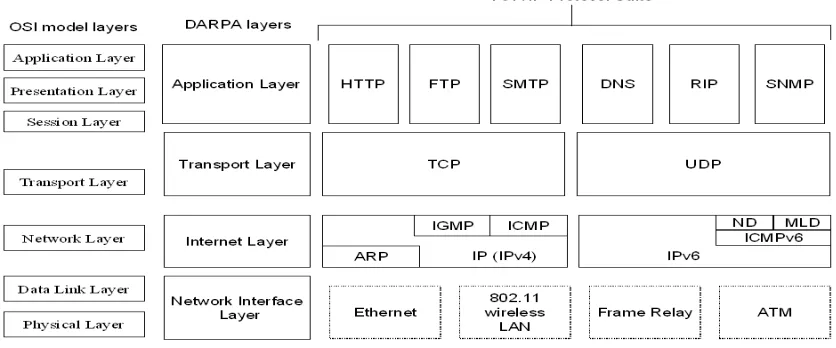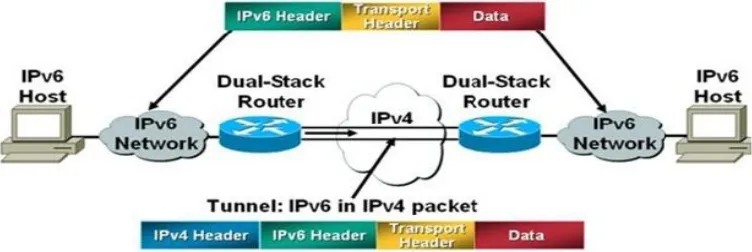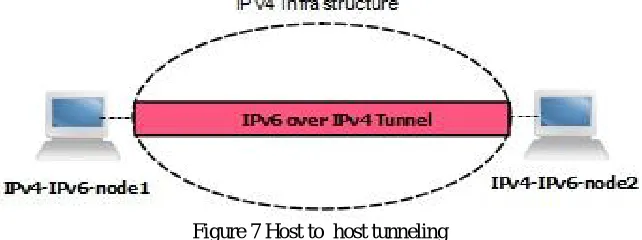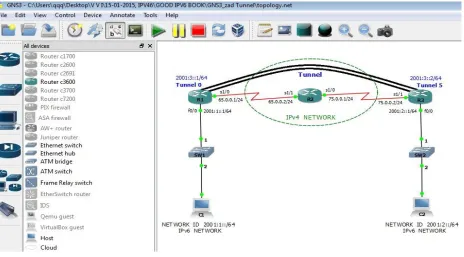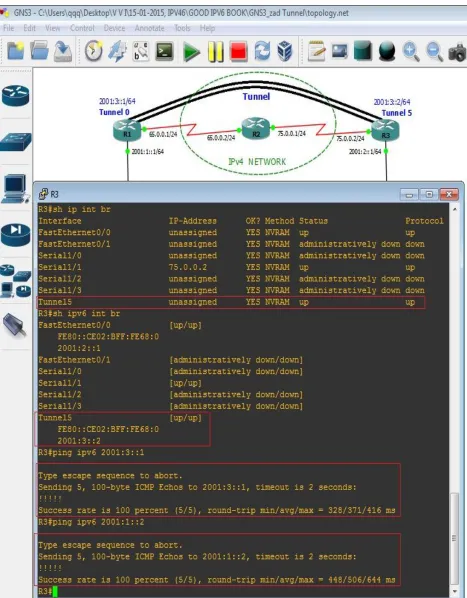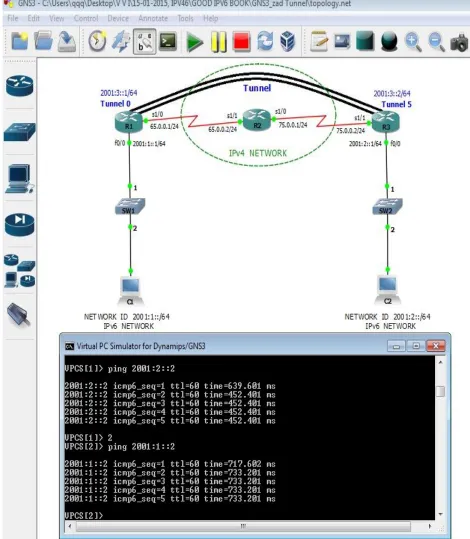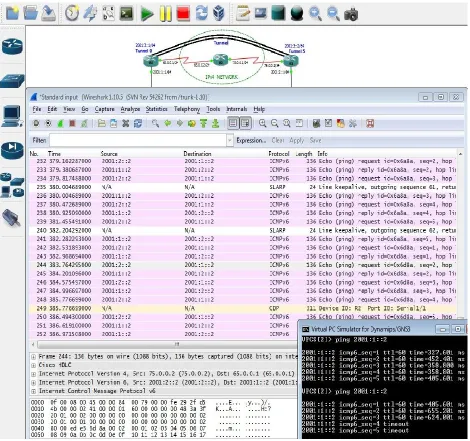ISSN(Online): 2320-9801
ISSN (Print): 2320-9798
I
nternational
J
ournal of
I
nnovative
R
esearch in
C
omputer
and
C
ommunication
E
ngineering
(An ISO 3297: 2007 Certified Organization)
Vol. 3, Issue 7, July 2015
Evaluation of IpV4 and IpV6 Tunneling 66
Mechanisms and To Establish A Permanent
Virtual Link between Two IpV6 Domains Over an
IpV4 Backbone
Mohammad Firoz Alam¹, Ravinder Kumar²
Reaserch Scholar, Department of Electronics & Communication Engineering, AFSET, Al-Falah University, Fridabad,
Haryana, India¹
Assistant Professor, Department of Electronics & Communication Engineering, AFSET, Al-Falah University, Fridabad,
Haryana, India²
ABSTRACT: The use of Internet Protocol (IP) based technologies is now a strategic element in the design, development and use of IP networks. As the use of IP-based networks, including the Internet, the Internet will continue to grow and the numbering system and the routing system will change to accommodate that growth. The most obvious change in going from IPv4 to IPv6 is the increase in the address space from 32 bits in IPv4 to 128 bits in IPv6. Internet Protocol version 6 (IPv6) is the new generation and the basic protocol of the Internet and every devices connected to the Internet must support it. The current version of IPv4 (IP version 4) has several shortcomings and in some cases present a barrier to the further development of the Internet. The coming IPv6 revolution should remove these barriers and provide a feature-rich environment for the future of global networking. To enable the integration of IPv6 into current networks, several transition mechanisms have been proposed by the IETF (Internet Engineering Task Force), namely Dual-stack techniques, Tunneling techniques and Translation techniques. This paper demonstrates and empirically evaluates one transition mechanism, namely IPv6 over IPv4 tunneling. The simulation is carried out using GNS3 to verify the presented approach.
KEYWORDS: Internet Protocol Ver.4 (IPv4), Internet Protocol Ver.6 (IPv6), TCP/IP protocol suite, IETF, ARPANET, NCP, GNS3, Dual Stack mechanism and Tunnel Mechanism.
I. INTRODUCTION
ISSN(Online): 2320-9801
ISSN (Print): 2320-9798
I
nternational
J
ournal of
I
nnovative
R
esearch in
C
omputer
and
C
ommunication
E
ngineering
(An ISO 3297: 2007 Certified Organization)
Vol. 3, Issue 7, July 2015
II. ARCHITECTURAL OVERVIEW OF THE TCP/IP PROTOCOL SUITE
The TCP/IP protocol suite is so named for two of its most important protocols namely Transmission Control Protocol (TCP) and Internet Protocol (IP).Transmission Control Protocol/Internet Protocol (TCP/IP) is an industry standard suite of protocols that is designed for large networks consisting of network segments that are connected by routers.The main design goal of TCP/IP was to build an interconnection of networks, referred to as an Internetwork, or Internet, that provided universal communication services over heterogeneous physical networks.The clear benefit of such an Internetwork is the enabling of communication between hosts on different networks, even separated by a large geographical area. In 1970, ARPANET hosts started to use Network Control Protocol (NCP), a preliminary form of what would become the Transmission Control Protocol (TCP). In1974, the Transmission Control Protocol (TCP) was specified in detail. TCP replaced NCP and provided enhanced reliable communication services. In 1981, the Internet Protocol (IP) (also known as IP version 4 (IPv4 ) was specified in detail. IP provides addressing and routing functions for end-to-end delivery. In 1982, the Defense Communications Agency (DCA) and ARPA established the Transmission Control Protocol (TCP) and Internet Protocol (IP) as the TCP/IP protocol suite. In 1983, ARPANET switched from NCP to TCP/IP. In 1984, the Domain Name System (DNS) was introduced. DNS resolves domain names (such as www.google.com) to IP addresses (such as 192.168.5.18). In 1996, the first set of IP version 6 (IPv6) standards were published.TCP/IPis the entire suite of protocols defined for use on private networks and the Internet. TCP/IP includes both the IPv4 and IPv6 sets of protocols. IPv4 has a 20 byte header while IPv6 has a 40 byte header.
Figure 1 The architecture of the TCP/IP protocol suite
III. TRANSITION AND COEXISTENCE MECHANISMS OF IPv4 / IPv6
ISSN(Online): 2320-9801
ISSN (Print): 2320-9798
I
nternational
J
ournal of
I
nnovative
R
esearch in
C
omputer
and
C
ommunication
E
ngineering
(An ISO 3297: 2007 Certified Organization)
Vol. 3, Issue 7, July 2015
Figure 2 IPv4 and IPv6 Transition and coexistence mechanism
To coexist with an IPv4 infrastructure and to provide an eventual transition to an IPv6-only infrastructure, the following mechanisms are used:
•Dual stack (Using both IPv4 and IPv6 or dual IP layer architectures)
•Tunneling (IPv6 over IPv4 tunneling) techniques
•Translation (IPv6 and IPv4 traffic translation)
IV. TUNNELING MECHANISMS
Tunneling mechanisms can be used to deploy an IPv6 forwarding infrastructure while the overall IPv4 infrastructure is still the basis and either should not or cannot be modified or upgraded. Tunneling is also called encapsulation. With encapsulation, one protocol (in our case, IPv6) is encapsulated in the header of another protocol (in our case, IPv4) and forwarded over the infrastructure of the second protocol (IPv4). The process of encapsulation has three components: • Encapsulation at the tunnel entry point
• Decapsulation at the tunnel exit point • Tunnel management
So tunneling can be used to carry IPv6 traffic by encapsulating it in IPv4 header and tunneling it over the IPv4 routing infrastructure. In the IPv4 header, the Protocol field is set to 41.General tunneling techniques and the encapsulation of IPv6 packets in IPv4 packets are defined in several RFCs, such as RFC 2473.
ISSN(Online): 2320-9801
ISSN (Print): 2320-9798
I
nternational
J
ournal of
I
nnovative
R
esearch in
C
omputer
and
C
ommunication
E
ngineering
(An ISO 3297: 2007 Certified Organization)
Vol. 3, Issue 7, July 2015
V. IPv6 OVER IPv4 TUNNELING
IPv6 over IPv4 tunneling is the encapsulation of IPv6 packets with an IPv4 header so that IPv6 packets can be sent over an IPv4 infrastructure. The Source and Destination fields are set to IPv4 addresses of the tunnel endpoints. The tunnel endpoints are either manually configured or are automatically derived from the sending tunnel interface and the next-hop address of the matching route for the destination IPv6 address in the tunneled packet.
Figure 4 IPv6 over IPv4 tunneling
RFC 2893 defines the following tunneling configurations with which to tunnel IPv6 traffic between IPv6/IPv4 nodes over an IPv4 infrastructure:
•Router-To-Router
In the router-to-router tunneling configuration, two IPv6/IPv4 routers connect two IPv6-capable infrastructures over an IPv4 infrastructure. The tunnel endpoints span a logical link in the path between the source and destination. The IPv6 over IPv4 tunnel between the two routers acts as a single hop. Routes within each IPv6-capable infrastructure point to the IPv6/IPv4 router on the edge.
Figure 5 Router-to-Router tunneling
•Host To Router or Router To Host
In the host-to-router tunneling configuration, an IPv6/IPv4 node that resides within an IPv4 infrastructure creates an IPv6 over IPv4 tunnel to reach an IPv6/IPv4 router. The tunnel endpoints span the first segment of the path between the source and destination nodes. The IPv6 over IPv4 tunnel between the IPv6/IPv4 node and the IPv6/IPv4 router acts as a single hop. In the router-to-host tunneling configuration, an IPv6/IPv4 router creates an IPv6 over IPv4 tunnel across an IPv4 infrastructure to reach an IPv6/IPv4 node. The tunnel endpoints span the last segment of the path between the source node and destination node. The IPv6 over IPv4 tunnel between the IPv6/IPv4 router and the IPv6/IPv4 node acts as a single hop.
ISSN(Online): 2320-9801
ISSN (Print): 2320-9798
I
nternational
J
ournal of
I
nnovative
R
esearch in
C
omputer
and
C
ommunication
E
ngineering
(An ISO 3297: 2007 Certified Organization)
Vol. 3, Issue 7, July 2015
Figure 6 Host-to-Router or Router-to-Host tunneling
•Host To Host
In the host-to-host tunneling configuration, an IPv6/IPv4 node that resides within an IPv4 infrastructure creates an IPv6 over IPv4 tunnel to reach another IPv6/IPv4 node that resides within the same IPv4 infrastructure. The tunnel endpoints span the entire path between the source and destination nodes. The IPv6 over IPv4 tunnel between the IPv6/IPv4 nodes acts as a single hop. On each IPv6/IPv4 node, an interface representing the IPv6 over IPv4 tunnel is created. IPv6 routes are added that use the tunnel interface. Based on the sending tunnel interface, the route, and the destination address, the sending node tunnels the IP v6 traffic to the next hop or to the destination. The IPv4 address of the tunnel endpoint can be manually configured or automatically determined from the next-hop address for the destination and the tunnel interface.
Figure 7 Host to host tunneling
VI. TYPES OF TUNNELS
RFC 2893 defines the following types of tunnels:
•Manually configured tunneling of IPv6 over IPv4
IPv6 packets are encapsulated in IPv4 packets to be carried over IPv4 routing infrastructures. These are point-to-point tunnels that need to be configured manually.
•Automatic tunneling of IPv6 over IPv4
An automatic tunnel is a tunnel that does not require manual configuration. Tunnel endpoints are determined by the use of logical tunnel interfaces, routes, and destination IPv6 addresses. IPv6 nodes can use different types of addresses, such as 6to4, 6rd, or ISATAP addresses, to dynamically tunnel IPv6 packets over an IPv4 routing infrastructure. These special IPv6 unicast addresses carry an IPv4 address in some parts of the IPv6 address fields, which can be used to determine the IPv4 address of the destination or the tunnel endpoint, respectively.
VII. DEVICES USED AND EXPERIMENTAL PROCEDURES
ISSN(Online): 2320-9801
ISSN (Print): 2320-9798
I
nternational
J
ournal of
I
nnovative
R
esearch in
C
omputer
and
C
ommunication
E
ngineering
(An ISO 3297: 2007 Certified Organization)
Vol. 3, Issue 7, July 2015
switches and two end-workstations C1 and C2 running windows 7 in two different sites. The entire testing process was carried out within the GNS3 Emulation Environment using a virtual topology. We explore the impact of this approach on end to end user application using “ping or tracert” command.The prime benefit of tunneling in the scenario is helping to understand the encapsulation of IPv6 packet in IPv4 header.The prime aim of this approach is to forward IPv6 packets of IPv6 network through IPv4 networks also. Configured tunneling is IPv6-over-IPv4 tunneling where the IPv4 tunnel endpoint addresses are determined by configuration information on the tunnel endpoints. All tunnels are assumed to be bidirectional. The tunnel provides a virtual point-to-point link to the IPv6 layer using the configured IPv4 addresses as the lower layer endpoint addresses. The administrative work to manage configured tunnels is higher than with automatic tunnels, but for security reasons it may be desirable, as it provides more possibilities to control the forwarding path of IPv6 packets.Typically, router-to-router tunneling configurations are manually configured.
Figure 8 Network with Tunnel over IPv4 infrastructure
VIII. ASSIGNING IP ADDRESSES AND PORTS TO THE NETWORKING DEVICES
Router Interface IP address Tunnel Interface IP address ---
R1 f0/0 2001:1::1/64 Tunnel 0 2001:3::1/64
s1/0 65.0.0.1/24
R2 s1/1 65.0.0.2/24 Tunnel 5 2001:3::2/64
s1/0 75.0.0.1/24
R3 s1/1 75.0.0.2/24 f0/0 2001:2::1/64
_____________________________________________________________________________________________
Workstation (VPC) Local port Remote port IP address
C1 30000 20000 IPv6 – 2001:1::2/64
C2 30001 20001 IPv6 – 2001:2::2/64
ISSN(Online): 2320-9801
ISSN (Print): 2320-9798
I
nternational
J
ournal of
I
nnovative
R
esearch in
C
omputer
and
C
ommunication
E
ngineering
(An ISO 3297: 2007 Certified Organization)
Vol. 3, Issue 7, July 2015
8.1 Configuration of Router R1, Cisco IOS commands are:
R1#configure terminal
R1(config)# interface fastethernet 0/0 R1(config-if)# ipv6 address 2001:1::1/64 R1(config-if)#no shutdown
R1(config-if)#exit
R1(config)#interface serial 1/0
R1(config-if)#ip address 65.0.0.1 255.255.255.0 R1(config-if)#no shutdown
R1(config-if)#encapsulation hdlc R1(config-if)#clockrate 64000 R1(config-if)#exit
R1(config)#
8.2 Configuration of Router R2, Cisco IOS commands are:
R2#configure terminal R2(config)#interface serial 1/1
R2(config-if)#ip address 65.0.0.2 255.255.255.0 R2(config-if)#no shutdown
R2(config-if)#encapsulation hdlc R2(config-if)#clockrate 64000 R2(config-if)#exit
R2(config)#
R2(config)#interface serial 1/0
R2(config-if)#ip address 75.0.0.1 255.255.255.0 R2(config-if)#no shutdown
R2(config-if)#encapsulation hdlc R2(config-if)#clockrate 64000 R2(config-if)#exit
8.3 Configuration of Router R3, Cisco IOS commands are:
R3#configure terminal
R3(config)# interface fastethernet 0/0 R3(config-if)# ipv6 address 2001:2::1/64 R3(config-if)#no shutdown
R3(config-if)#exit
R3(config)#interface serial 1/1
R3(config-if)#ip address 75.0.0.2 255.255.255.0 R3(config-if)#no shutdown
R3(config-if)#encapsulation hdlc R3(config-if)#clockrate 64000 R3(config-if)#exit
R3(config)#
8.4 Tunnel 0 end configuration, Cisco IOS commands are:
R2#configure terminal R2(config)#no ip routing R2(config)# ip routing R1#configure terminal R1(config)#no ip routing R1(config)# ip routing
ISSN(Online): 2320-9801
ISSN (Print): 2320-9798
I
nternational
J
ournal of
I
nnovative
R
esearch in
C
omputer
and
C
ommunication
E
ngineering
(An ISO 3297: 2007 Certified Organization)
Vol. 3, Issue 7, July 2015
R1(config)# int tunnel 0
R1(config)#ipv6 address 2001:3::1/64 R1(config)#no shutdown
R1(config)#tunnel source s1/0
R1(config)#tunnel destination 75.0.0.2 R1(config)#tunnel mode ipv6ip R1(config)#ip route 0.0.0.0 0.0.0.0 s1/0 R1(config)#ipv6 route 2001:2::/64 tunnel 0 R1(config)#exit
8.5 Tunnel 5 end Configuration, Cisco IOS commands are:
R3#configure terminal R3(config)#no ip routing R3(config)# ip routing
R3(config)#no ipv6 unicast-routing R3(config)# ipv6 unicast-routing R3(config)# int tunnel 5
R3(config)#ipv6 address 2001:3::2/64 R3(config)#no shutdown
R3(config)#tunnel source s1/1
R3(config)#tunnel destination 65.0.0.1 R3(config)#tunnel mode ipv6ip R3(config)#ip route 0.0.0.0 0.0.0.0 s1/1 R3(config)#ipv6 route 2001:1::/64 tunnel 5 R3(config)#exit
IX.SIMULATION RESULTS
ISSN(Online): 2320-9801
ISSN (Print): 2320-9798
I
nternational
J
ournal of
I
nnovative
R
esearch in
C
omputer
and
C
ommunication
E
ngineering
(An ISO 3297: 2007 Certified Organization)
Vol. 3, Issue 7, July 2015
ISSN(Online): 2320-9801
ISSN (Print): 2320-9798
I
nternational
J
ournal of
I
nnovative
R
esearch in
C
omputer
and
C
ommunication
E
ngineering
(An ISO 3297: 2007 Certified Organization)
Vol. 3, Issue 7, July 2015
ISSN(Online): 2320-9801
ISSN (Print): 2320-9798
I
nternational
J
ournal of
I
nnovative
R
esearch in
C
omputer
and
C
ommunication
E
ngineering
(An ISO 3297: 2007 Certified Organization)
Vol. 3, Issue 7, July 2015
Figure 11 Communication between end Workstations C1 and C2
ISSN(Online): 2320-9801
ISSN (Print): 2320-9798
I
nternational
J
ournal of
I
nnovative
R
esearch in
C
omputer
and
C
ommunication
E
ngineering
(An ISO 3297: 2007 Certified Organization)
Vol. 3, Issue 7, July 2015
Figure 12 Packet capturing at Router interface
X. CONCLUSION
ISSN(Online): 2320-9801
ISSN (Print): 2320-9798
I
nternational
J
ournal of
I
nnovative
R
esearch in
C
omputer
and
C
ommunication
E
ngineering
(An ISO 3297: 2007 Certified Organization)
Vol. 3, Issue 7, July 2015
incompatible networks and IPv6 over IPv4 tunneling does not provide security for tunneled IPv6 packets. Up to date, there exist different Tunneling methods such as 6to4, ISATAP, Teredo, DSTM, and 6over4.
REFERENCES
1. Martin Dunmore,(An IPv6 Deployment Guide), The 6NET Consortium, September 2005. 2. Understanding IPv6 by Joseph Devies, Microsoft 3rd Edition.
3. Cisco.com IPv6 information at http://www.cisco.com/ipv6
4. Cisco Certified Network Associated by Richard Deal,Tata Mcgraw-Hill Edition, 2010 5. ICND2 Official Exam Certification Guide by Wendell Odom. 2E, Cisco Press 6 .IPv6 Essentials, Third Edition by Silvia Hagen
7. Cisco, Introduction to IPv6 by Villayat Muhammad, Service Provider Solution Architect
8. Prepare today for tomorrow’s IPv6 world sustaining business continuity in a dual-protocol environment, Business white paper.
9. Transmission of IPv6 Packets over IPv4 Domains without Explicit Tunnels" ("6over4"), RFC 2529 at http://www.ietf.org/rfc/rfc2529.txt 10. IPv4 & IPv6 Integration and Transition / Mohd.Firoz Alam* , Jai Singh and Ravinder Kumar / VSRD International Journal of
Electrical, Electronis & Communication Engineering, Vol. V Issue June 2015 e-ISSN:2231-3346, p-ISSN:2319-2232@
www.vsrdjournals.com
11. Establishing Link between IPv6 Networks Using IPv4 Clouds / Junaid Qayyum, Fayyaz Gul / International Journal of Video & Image Processing and Network Security IJVIPNS-IJENS Vol: 11 No: 03
12. CCNP ROUTE 642-902 Official Certification Guide by Cisco.
